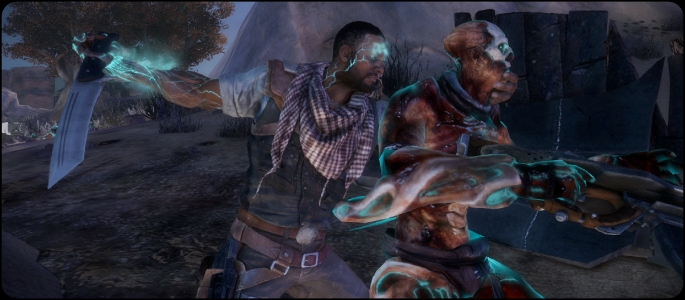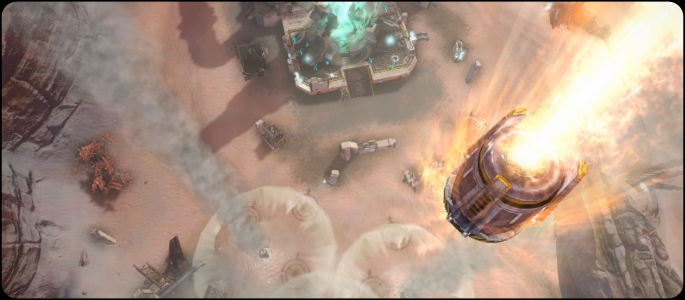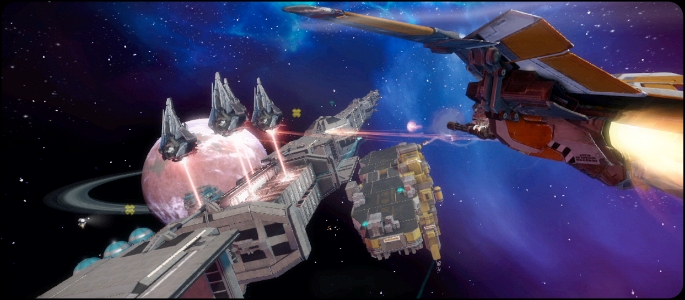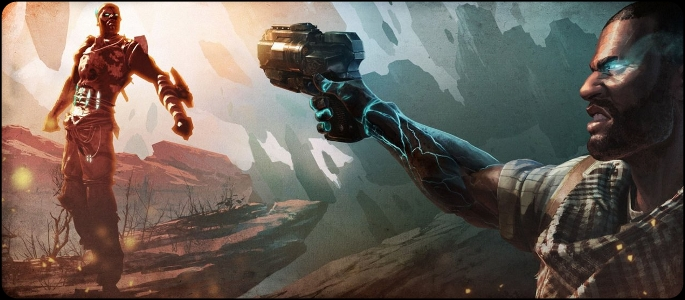Starhawk, LightBox Interactive’s spiritual follow-up to the online-only PlayStation 3 exclusive Warhawk, is about to drop on Sony’s home console. But is it the worthy successor that fans have wanted?
Starhawk walks a very fine line of being a lot like Warhawk, and being completely different. The feel of the gameplay, the team-based strategy, and the vehicular combat closely resemble that of the early PS3 game, but a single-player mode, co-op, and a new build while you battle system make a world a difference in the end product.
The single-player story is told through the narration and actions of Emmett Graves, a contract Rifter who has been infected by Rift energy. His world’s economy revolves around the mining of this dangerous resource, and such, different factions fight to claim it for their own. It’s like the Gold Rush in early American ‘Wild West’, and the music and desert-like settings help to make for a Space Cowboy-type theme.
Emmett found out just how volatile the Rift can be, as an explosion of it infected and took the life of his brother. Like many others infected, Emmett glows the same teal blue color as the Rift itself. The only reason Emmett hasn’t turned into an Outlaw—a once-human lifeform overcome with this Rift infection—is because his comrade Cutter stopped the infection before it was too late. Other humans mining on the Frontier aren’t so lucky, and are turned into Outlaw “scabs”.

Unfortunately, the story is uninspired and disappointingly cookie cutter all the way through to the end. Even the big surprise is easily anticipated and almost expected. With Starhawk, though, the story in single-player is the last thing you should care about. Although it’s a hell of a lot of fun in and of itself, the real benefit single-player offers is that it acts as a four- to five-hour tutorial on how to properly strategize and utilize the game’s Build & Battle mechanic in multiplayer and co-op. Without it, multiplayer can easily become overwhelming.
Following Warhawk’s legacy, multiplayer acts as Starhawk’s main dish, and rightfully so—it’s where the action is. Given the wealth of vehicles and structures you can build using the Build & Battle system, no two multiplayer matches will ever be the same. Build & Battle works effortlessly at the press of a button. Once enough Rift energy is absorbed, simply press triangle to bring up the wheel of available choices—everything from standard, connectable walls, to Supply Bunkers and Turrets, to Tanks or the series’ mainstay “Hawks” (which are now transformable mech suits rather than just warplanes).
Don’t try to be a lone-wolf hero; it won’t work, and will have you doing more respawning than building. Although even respawning itself can be used to your advantage as a form of attack, as you enter the battlefield in a drop pod that can destroy enemy structures or even take out the opposition. The vehicles and structures you build drop out of the sky in a similar fashion, so be wary of placement so that you don’t drop an Outpost on yourself… which will kill you.

Constructing a balanced mix of defense, support, and offense is paramount to victory, and enjoyment. This heavily relies on your fellow teammate’s ability to plan accordingly, and be willing to work together toward a common goal; which make Starhawk the perfect game for serious clans. Knowing this, LightBox Interactive has added full clan support and a wide host of community features including an event calendar, leaderboards, in-game invites and friend’s lists, tournaments and more. There’s even an Android application incoming that lets users track their clan and Starhawk stats wherever they are.
In addition to the 32-player multiplayer’s Zones, Capture the Flag, Deathmatch and Team Deathmatch modes, Starhawk offers a co-op ‘Prospector Mode’. Here, two players can team up to build a Rift-mining rig, which must be defended from an increasingly difficult onslaught of Outlaw scabs. Again, a strong balance of offense and defense is important here, but the action plays out more like that of the single-player mode than the multiplayer.
Regardless of what mode you’re playing, the action is intense, shooting is fast-paced, and the strategy is challenging and rewarding. Mastering and using each of the structures and vehicles available in Build & Battle takes practice, but pays off in spades once you get the hang of it. Playing the single-player campaign first before jumping into multiplayer can save you a world of grief.

As you play, you earn XP to unlock a variety of skills to give you an edge on the battlefield. Customization doesn’t end there—you can even alter the look of Razorbacks, Hawks and Sidewinders to add your personal (or clan’s) flair.
Environments, both in single or multiplayer are vast and expansive, giving off an intergalactic, but Western vibe. The graphics, though, are awful. After seeing what other PS3 games are capable of, Starhawk looks like an early PS3 title. During battle this isn’t that striking, but during some of the non-animated story sequences, character models are lacking detail. Enemies are, for the most part, very bland.
Cutscenes, however, are done in a motion-comic style and look excellent—very reminiscent of another PS3 exclusive, inFamous. In fact, a lot of Starhawk reminds me of inFamous: the action, the movement, the story is told split through action and narration, the absorbing of energy, and the way your comrade is constantly in your ear. Even the ending feels similar in ways. That’s not really a bad thing, because inFamous was a great game. But there is an unmistakable air of familiarity between what’s mentioned above and through the deep roots of Warhawk.
As a complete package, Starhawk isn’t a groundbreaking PS3 exclusive in the way that Uncharted or God of War is. It’s lacking in a few areas, keeping it short of greatness. But if you liked Warhawk, enjoy strategy in your multiplayer, or are thoroughly ingrained in a clan, then Starhawk will be welcome break from the norm. And even if those points aren’t your thing, although not quite a must-have, Starhawk is still worth trying—it’s a pleasant surprise.
PlayStation LifeStyle’s Final Score
+Plenty of multiplayer-focused community features in tow. -Graphics and tired story hamper the experience. |
 |
–








